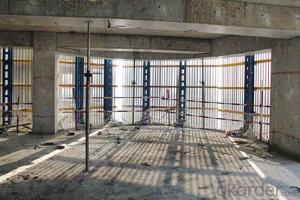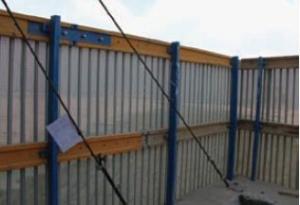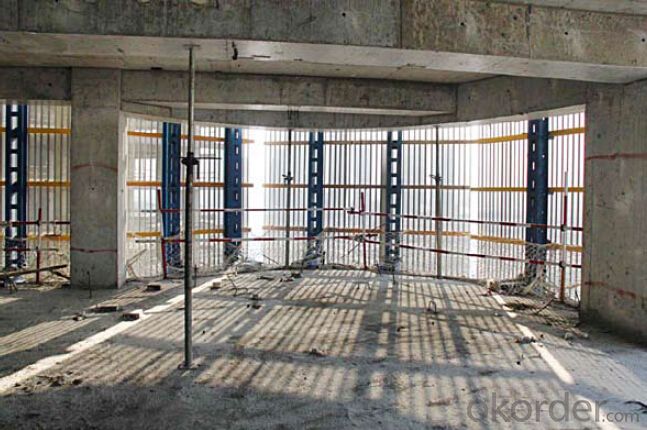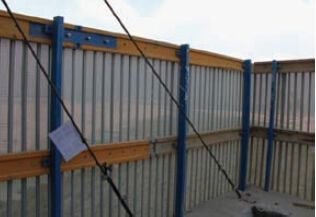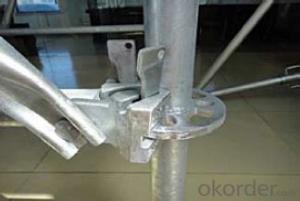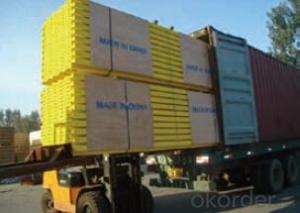Protection Platform for Formwork and Scaffolding Systems
- Loading Port:
- Tianjin
- Payment Terms:
- TT OR LC
- Min Order Qty:
- 50 m²
- Supply Capability:
- 1000 m²/month
OKorder Service Pledge
OKorder Financial Service
You Might Also Like
Protection Platform PP-50
A kind of new type construction protection system, applying operating platform and safer job
location for construction corps.
Characteristics:
◆ Easy and quick assembling.
◆ Lifted as a group, it is rapid and economic.
◆ Auto-climbing
◆ A safe and reliable anchor system
1. Composition
2. Assembly process of anchor system
(1) Embed V-climbing cone and anchor plate into the slab.
(2) Fix anchor shoe on the slab by tensile bolt.
(3) The fixed anchor shoe.
◆ High work efficiency with work platform and unload platform
◆ High light transmittance with the hollow block
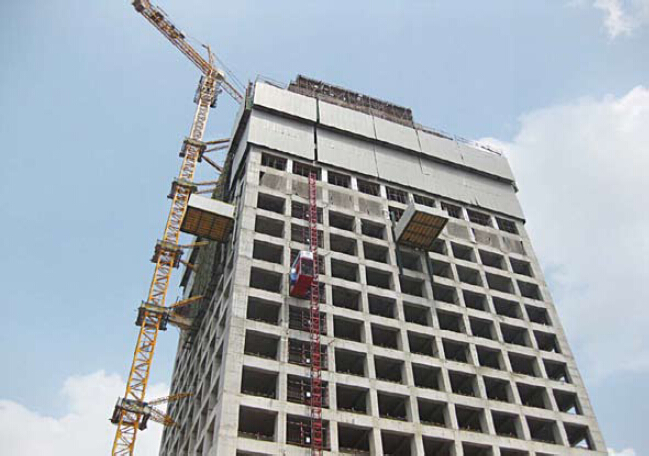

- Q: How does steel formwork affect the overall construction project management?
- Steel formwork can have a significant impact on overall construction project management. Here are a few ways it can affect the management of a construction project: 1. Time efficiency: Steel formwork is known for its durability and reusability, which can help save time during construction. With proper planning and coordination, steel formwork can be easily assembled and disassembled, allowing for faster construction progress. This time efficiency can lead to better project scheduling and improved overall project management. 2. Cost-effectiveness: Although steel formwork may have a higher initial cost compared to other formwork materials, its ability to be reused multiple times makes it a cost-effective choice in the long run. As a result, project managers can allocate their budget more efficiently, reducing unnecessary expenses and ensuring the project stays within the allocated cost limits. 3. Quality control: Steel formwork provides a smooth and uniform finish to concrete structures. This allows project managers to maintain high-quality standards throughout the construction process. By using steel formwork, project managers can ensure that the final product meets the required specifications and standards, reducing the need for rework and potential delays. 4. Safety and durability: Steel formwork is known for its strength and stability, making it a safe choice for construction projects. Its robustness helps prevent accidents on-site and provides a secure work environment for construction workers. Additionally, the durability of steel formwork ensures that it can withstand the pressures exerted during the concrete pouring process, reducing the risk of structural failures and subsequent rework. 5. Flexibility and adaptability: Steel formwork offers a high degree of flexibility, allowing project managers to adapt to changes and modifications in the construction plans. Whether it's adjusting the formwork design or reusing the same formwork for different parts of the project, the flexibility of steel formwork enables project managers to respond quickly to unforeseen circumstances, minimizing project disruptions. In conclusion, steel formwork can significantly impact the overall construction project management by improving time efficiency, cost-effectiveness, quality control, safety, and flexibility. Its durability and reusability make it a valuable asset for project managers, enabling them to deliver projects on time, within budget, and to the desired quality standards.
- Q: What are the common design considerations for steel formwork?
- Some common design considerations for steel formwork include the strength and stability of the structure, ease of assembly and disassembly, dimensional accuracy, resistance to deformation or warping, durability against repeated use, compatibility with other construction materials, and ability to accommodate various concrete mix designs and pouring techniques. Additionally, factors such as cost-effectiveness, safety, and environmental impact are also taken into account during the design process.
- Q: Are there any specific quality control measures for steel formwork installation?
- Yes, there are specific quality control measures for steel formwork installation. These quality control measures are put in place to ensure that the steel formwork is installed correctly and meets the required standards. One of the key quality control measures is the inspection of the steel formwork before installation. This involves checking the formwork for any damages, defects, or deviations from the required specifications. Any issues found during the inspection should be addressed and resolved before proceeding with the installation. Another quality control measure is the verification of the dimensions and alignment of the steel formwork. This is done to ensure that the formwork is fabricated according to the required dimensions and that it is properly aligned with the structure. Inaccurate dimensions or misalignment can lead to problems during the concrete pouring process and can affect the quality of the final structure. Additionally, quality control measures include checking the stability and strength of the steel formwork. This involves verifying that the formwork is properly braced and supported to withstand the pressure exerted by the concrete. It is important to ensure that the formwork can handle the load without any deformation or failure. Furthermore, the installation process itself should be closely monitored to ensure compliance with the required procedures and standards. This includes checking that the formwork is securely fastened and that all connections are properly made. Any deviations from the installation procedures should be immediately addressed and corrected. Regular inspections and audits should be conducted throughout the installation process to track the progress and identify any potential issues. This allows for timely interventions and corrections, ensuring that the steel formwork installation meets the required quality standards. Overall, specific quality control measures for steel formwork installation are essential to ensure the integrity and safety of the structure. By implementing these measures, any potential issues or defects can be identified and resolved early on, minimizing the risk of costly rework or structural failures.
- Q: How does steel formwork impact the overall energy efficiency of a structure?
- Steel formwork can have a significant impact on the overall energy efficiency of a structure. Firstly, steel formwork is highly durable and can be used repeatedly, reducing the need for new formwork materials for each construction project. This reduces the energy consumption associated with manufacturing and transporting formwork materials. Furthermore, steel formwork is known for its excellent thermal conductivity, which allows for efficient heat transfer. This property is particularly important in structures where energy efficiency is a priority, such as residential or commercial buildings. Efficient heat transfer can help maintain a comfortable indoor temperature, reducing the need for excessive heating or cooling, and thus minimizing energy consumption. In addition, steel formwork can contribute to the overall insulation of a structure. By using insulating materials in combination with steel formwork, a building's thermal performance can be significantly improved. This insulation helps to prevent heat loss during colder months and heat gain during warmer months, reducing the reliance on artificial heating and cooling systems. Consequently, energy consumption is reduced, leading to improved energy efficiency. Moreover, steel formwork can be designed to incorporate features that enhance natural lighting and ventilation in a structure. By allowing more natural light to enter the building, the need for artificial lighting during daylight hours is reduced, resulting in lower energy consumption. Similarly, by promoting natural ventilation, steel formwork can reduce the need for mechanical ventilation systems, further contributing to energy efficiency. Lastly, steel formwork's strength and stability allow for the construction of innovative and energy-efficient structural designs. It enables the use of larger open spaces, reducing the need for additional structural components and materials. This not only reduces construction costs but also lowers energy consumption associated with the production and transportation of these additional materials. In conclusion, steel formwork positively impacts the overall energy efficiency of a structure through its durability, thermal conductivity, insulation properties, natural lighting and ventilation features, and its ability to enable innovative structural designs. By reducing energy consumption in various ways, steel formwork contributes to the sustainability and long-term energy efficiency of a building.
- Q: How does steel formwork handle different concrete surface cleaning methods?
- Concrete construction projects can benefit from the durability and versatility of steel formwork. When it comes to cleaning the concrete surface, steel formwork proves to be highly effective and adaptable. Pressure washing is a common method used to clean concrete surfaces. Steel formwork can withstand the force of high-pressure water jets without sustaining any damage. The smooth and non-porous nature of the steel formwork surface facilitates the removal of dirt, debris, and other unwanted materials. By utilizing pressure washing, a smooth and even finish can be achieved. Chemical cleaning is another technique employed for cleaning concrete surfaces. Steel formwork is resistant to the majority of chemicals commonly used for cleaning purposes. This allows for the usage of various cleaning agents to eliminate stubborn stains, oil, grease, and other contaminants from the concrete surface. The chemical cleaning process can be carried out without causing any harm or deterioration to the steel formwork. Manual cleaning methods may also be utilized in certain instances. Steel formwork can withstand manual scrubbing, brushing, or scraping without any issues. The strength and durability of steel make it suitable for manual cleaning methods, which may be necessary when dealing with tough stains or debris that cannot be easily removed through other means. In conclusion, steel formwork is an ideal choice for handling various concrete surface cleaning methods. Its resistance to pressure washing, chemical cleaning, and manual cleaning ensures that the concrete surface can be effectively cleaned without damaging the formwork. This allows for a clean and visually appealing finish while maintaining the structural integrity of the formwork.
- Q: Concrete, reinforcing steel for the labor price? 18 storey elevator apartment with a layer of underground carpentry, concrete, steel artificial price. (to the workers to do the Contractor) the problem added: steel, including the production and installation of a full set of artificial ha, concrete is mixed business. Template carpenter??? Concrete with nails??? Steel??? Including machine...Is the area of 10000 square meters of construction area template?How many tons of steel?
- The main body of the wall and inside and outside the powder to the construction area of 70/M2 (including small equipment)10000 square meters of construction area by the consideration of the template to pay two, the need for a template of 10000 square metersThere are about 6~700 tons of rebar
- Q: What are the considerations when designing steel formwork for elevated walkways?
- When designing steel formwork for elevated walkways, several considerations need to be taken into account. Firstly, the load capacity of the walkway must be carefully calculated to ensure it can support the intended weight of pedestrians and any additional loads such as furniture or equipment. The structural integrity of the formwork is crucial, requiring the use of high-quality steel and appropriate reinforcement to withstand the stresses and forces it will experience. Additionally, safety is a paramount consideration. The formwork must be designed to provide sufficient strength and stability, incorporating features like handrails and non-slip surfaces to prevent accidents and ensure user safety. Adequate access points and emergency exits should also be incorporated into the design. Durability is another important factor. Steel formwork for elevated walkways should be resistant to corrosion and weathering, as these structures are often exposed to various environmental conditions. Proper protective coatings and maintenance strategies should be implemented to ensure the longevity of the formwork. Lastly, the aesthetics of the walkway should be considered. The design should be visually appealing and harmonize with the surrounding environment or architectural style. Attention should be given to details such as finishes, color schemes, and integration with other elements of the overall design. Overall, the considerations when designing steel formwork for elevated walkways encompass load capacity, structural integrity, safety, durability, and aesthetics to create a functional, safe, and visually appealing structure.
- Q: What are the factors to consider when selecting steel formwork?
- When selecting steel formwork, there are several factors to consider. 1. Strength and durability: Steel formwork should be strong enough to withstand the weight of the concrete and the forces applied during the pouring and curing process. It should also be able to withstand multiple uses without losing its structural integrity. 2. Flexibility and adaptability: The formwork should be able to be easily adjusted and modified to accommodate different shapes and sizes of concrete elements. This is particularly important in construction projects that involve complex or irregular structures. 3. Ease of assembly and dismantling: The formwork system should be quick and easy to assemble and dismantle, as this can significantly impact the overall construction timeline. The use of standardized components and a simple connection system can contribute to faster assembly and dismantling. 4. Surface finish: The quality of the surface finish of the concrete is important, especially for architectural projects. Steel formwork should provide a smooth and even surface, without any visible marks or imperfections, to ensure a high-quality end result. 5. Cost-effectiveness: The overall cost of the formwork system, including the initial investment, maintenance, and reusability, should be considered. While steel formwork may have a higher upfront cost compared to other materials, its durability and reusability can make it a cost-effective choice in the long run. 6. Safety: The safety of workers during the construction process is paramount. Steel formwork should be designed and manufactured with safety features such as non-slip surfaces, secure connections, and adequate bracing to prevent accidents or collapses. 7. Environmental impact: The environmental impact of the formwork material should also be taken into account. Steel formwork is often considered more environmentally friendly compared to traditional timber formwork due to its reusability and recyclability. By considering these factors, construction professionals can make an informed decision when selecting steel formwork that meets their project requirements and delivers optimal results.
- Q: How does steel formwork affect the overall durability of the structure?
- Steel formwork can significantly enhance the overall durability of a structure. Its robustness and strength provide excellent support and stability during the concrete pouring process, ensuring that the structure maintains its intended shape and alignment. Steel formwork also offers exceptional resistance to deformation, making it highly durable and capable of withstanding the pressures exerted by the concrete. Moreover, steel formwork reduces the risk of cracks and structural failures, resulting in a more long-lasting and resilient structure.
- Q: How does steel formwork handle architectural features such as openings and recesses?
- Steel formwork proves to be an adaptable construction material capable of effectively managing architectural features like openings and recesses. Its strength and flexibility render it perfect for accommodating these design elements in concrete structures. In terms of openings, such as windows or doors, steel formwork can be easily customized to yield precise and well-defined openings. The formwork panels can be cut or shaped to the preferred size and shape, enabling accurate placement of the concrete around the opening. It also provides stability and support during the pouring and curing process, ensuring the structural soundness of the concrete surrounding the opening. On the other hand, recesses can be effortlessly formed using steel panels specifically engineered to create the desired recessed area. These panels can be shaped or molded to match the architectural design, facilitating a seamless integration of recesses into the concrete structure. Steel formwork allows for meticulous control over the depth and dimensions of the recess, guaranteeing compliance with the design requirements. In addition to its adaptability, steel formwork offers several advantages when dealing with architectural features. Its durability and resistance to deformation enable it to withstand the pressure exerted by the concrete, thereby preserving the formwork's shape throughout the construction process. This is crucial in maintaining the accuracy and integrity of architectural features. Moreover, steel formwork is reusable, making it a cost-effective option for projects involving multiple openings and recesses. The panels can be disassembled, cleaned, and reassembled for future use, reducing the need for new formwork materials and minimizing waste. To summarize, steel formwork is a dependable and efficient choice for managing architectural features like openings and recesses. Its strength, flexibility, and reusability make it an ideal construction material for creating precise and visually appealing architectural designs.
Send your message to us
Protection Platform for Formwork and Scaffolding Systems
- Loading Port:
- Tianjin
- Payment Terms:
- TT OR LC
- Min Order Qty:
- 50 m²
- Supply Capability:
- 1000 m²/month
OKorder Service Pledge
OKorder Financial Service
Similar products
Hot products
Hot Searches
Related keywords
